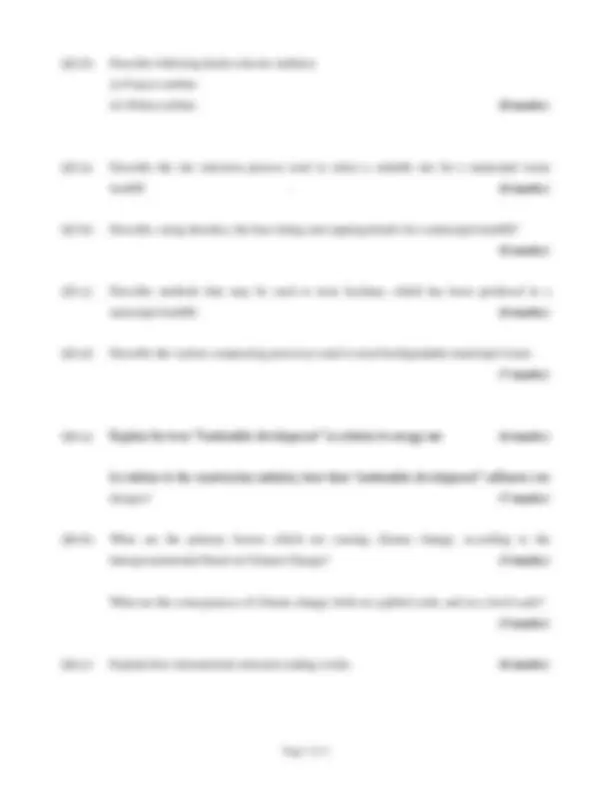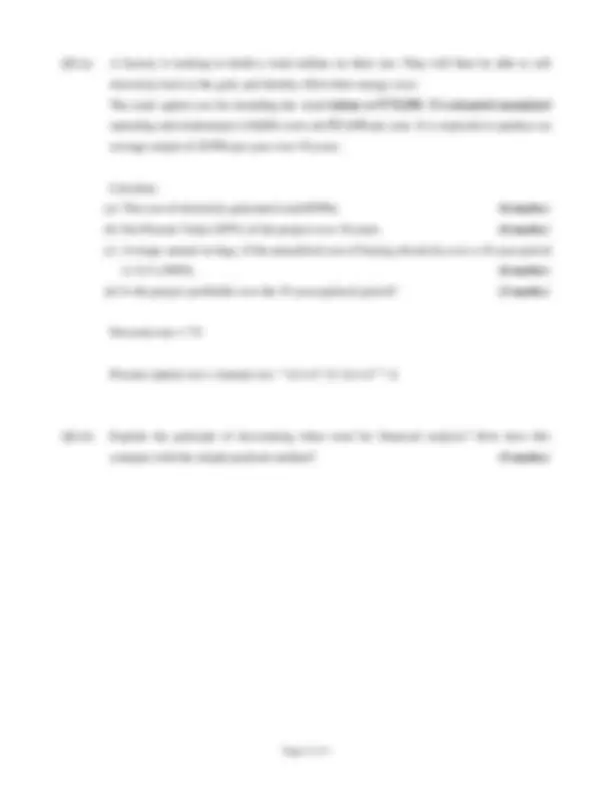




Study with the several resources on Docsity

Earn points by helping other students or get them with a premium plan


Prepare for your exams
Study with the several resources on Docsity

Earn points to download
Earn points by helping other students or get them with a premium plan
Community
Ask the community for help and clear up your study doubts
Discover the best universities in your country according to Docsity users
Free resources
Download our free guides on studying techniques, anxiety management strategies, and thesis advice from Docsity tutors
An examination paper from the cork institute of technology for the module environmental engineering 2 (civl7007), which is part of the bachelor of engineering in civil engineering program. Instructions for candidates, questions on various topics related to environmental engineering such as environmental impact assessments (eia), wind turbine systems, hydro-electric turbines, site selection for municipal waste landfills, sustainable development, and financial analysis of wind energy projects.
Typology: Exams
1 / 4

This page cannot be seen from the preview
Don't miss anything!



Autumn Examinations 2010
Module Code: CIVL
School: Building and Civil Engineering
Programme Title: Bachelor of Engineering in Civil Engineering
Programme Code: CCIVL_7_Y 3
External Examiner(s): Mr. J. Murphy, Ms. Maria Kyne Internal Examiner(s): Mr. T.L. O’Driscoll, Mr. S. Harrington
Instructions: Answer four questions.
Duration: 2 hours
Sitting: Autumn 2010
Requirements for this examination:
Note to Candidates: Please check the Programme Title and the Module Title to ensure that you have received the correct examination paper. If in doubt please contact an Invigilator.
Q1.(a) Describe the Environmental Impact Assessment (EIA) process as required in the planning process by Irish Law. (7 marks)
Q1.(b) Explain the following terms as used in the EIA process: (i) Thresholds (2 marks) (ii) Mitigation (2 marks) (iii) Screening. (2 marks)
Q1.(c) An EIA is required for a new motorway in a rural location. Describe likely negative impacts under the following headings, and possible mitigation measures that may be used: (i) Fauna (ii) Cultural heritage (iii) Air (iv) Material assets. (12 marks)
Q2.(a) Compare two possible options for a wind turbine system design as follows: Option A: 8 turbines @ 85m height, with 3 rotors, each 3 0 m long. Option B: 5 turbine @ 115m high, with 3 rotors, each 40m long.
The annual average wind-speed at the site is 6.5m/s @ 85m height. Ground roughness class at the site = 1 Roughness length = 0.03m. K=3.2 for both options.
Average annual power (kWh/year) = K.Vm^3 .At.T
VZ = Vref * [ln(Z/Z 0 )/ln(Zref /Z 0 )] . Calculate the average annual power generated for each system. (10 marks)
What other factors would need to be taken into account when deciding on the best option for the wind energy system above? (7 marks)
Q5.(a) A factory is looking to build a wind turbine on their site. They will then be able to sell electricity back to the grid, and thereby offset their energy costs. The total capital cost for installing the wind turbine is €750,000. It’s estimated annualized operating and maintenance (O&M) costs are €1 5 ,000 per year. It is expected to produce an average output of 2GWh per year over 10 years.
Calculate: (a) The cost of electricity generated (cent/KWh). (6 marks) (b) Net Present Value (NPV) of the project over 10 years. (6 marks) (c) Average annual savings, if the annualized cost of buying electricity over a 10 year period is 12.5 c/KWh. (6 marks) (d) Is the project profitable over the 10 year payback period? (2 marks)
Discount rate = 7%
Present capital cost = Annual cost * [(1+r)n-1] / [(1+r)n^ * r]
Q5.(b) Explain the principle of discounting when used for financial analysis? How does this compare with the simple payback method? (5 marks)